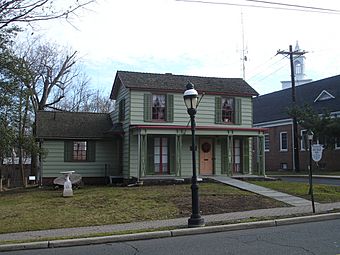Crane-Phillips House facts for kids
Quick facts for kids |
|
|
Crane-Philips House
|
|
 |
|
| Location | 124 N. Union Avenue Cranford, New Jersey |
|---|---|
| NRHP reference No. | 97000842 |
| Added to NRHP | August 14, 1997 |
The Crane-Phillips House is a historic home in Cranford, New Jersey. It is located at 124 N. Union Avenue. This house is a great example of a Victorian cottage. It was designed in the style of Andrew Jackson Downing, an early American architect.
Today, the Crane-Phillips House is a museum. The Cranford Historical Society runs it. Visitors can see what life was like for a regular family during the Victorian era. This was a time of many new inventions. The museum shows how these inventions changed daily life.
The Phillips family, who lived here later, were inventors. Henry J. Phillips was a veteran of the American Civil War. He helped invent the modern kitchen hood. He also created a tent and overcoat that could be used by soldiers. His brother, Charles Henry Phillips, invented Phillips' Milk of Magnesia.
The museum has many interesting items. You can see Native American tools and artifacts. There are also items from the American Revolutionary War and the American Civil War. The house features a Victorian living room and a girl's bedroom from around 1870. The museum also keeps many documents about Cranford's history. They often have special displays of old clothing.
History of the Crane-Phillips House
The Crane-Phillips House is sometimes called "The Little House on the Rahway." It was first built around 1840. Josiah Crane built it as a honeymoon cottage for his son, Josiah Crane Jr. The Crane family were among the first settlers in this area. They arrived in the early 1700s, around 1715.
The Cranes built mills on the Rahway River. They also started a farm on the west side of the river. Josiah Crane Jr. sold the house in 1867. Henry and Cecelia Phillips bought it. They lived there until Henry passed away in 1911. The Phillips family added many parts to the cottage in the Downing style.
Bringing the House Back to Life
The Cranford Historical Society worked hard to restore the museum. They wanted it to look like it did in the late 1800s. They also updated the building and created new exhibits. One new part is an old-fashioned kitchen from the late 19th century.
This restoration turned the "Little House" into a living history museum. Guides, called docents, help visitors imagine life in the past. The museum shows local history from three centuries. It also connects this history to New Jersey and the United States.
The Crane-Phillips House Museum is listed on the National and State Register of Historic Places. In 1999, it was named an "American Treasure." This honor came from the White House Millennium Council and the National Trust for Historic Preservation. It is one of several important historic homes in Cranford.
More to Explore


